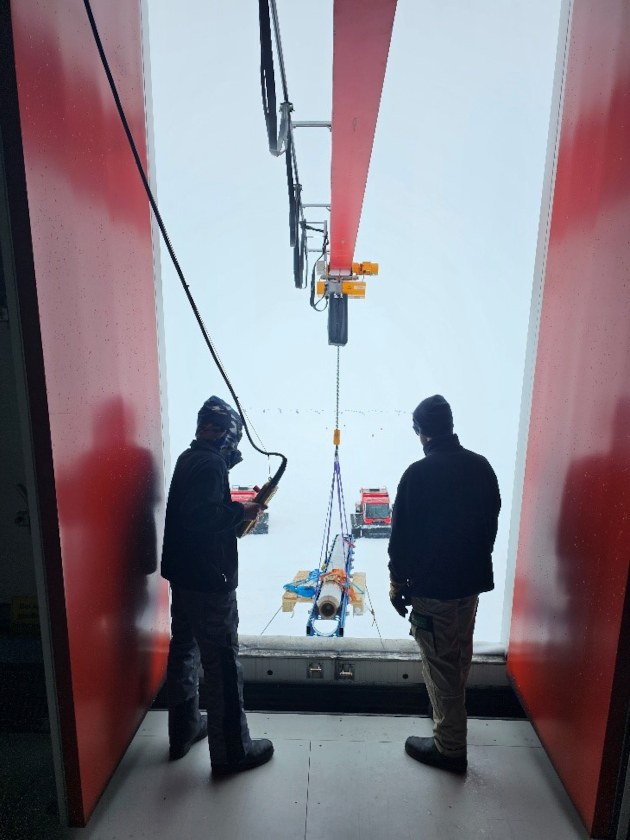Second TRIPLE-IceCraft expedition to the Antarctic: Between battling a snowstorm and loading a dishwasher – Part 2

DLR/RWTH Aachen/Dirk Heinen
Today's weather is unpleasant, with light snow drifts and wind speeds of up to 20 knots (37 kilometres per hour). And tomorrow is expected to be even worse. Before then, we plan to bring the TRIPLE-IceCraft melting probe to Neumayer Station III. To do this, we will remove the probe from the container and place it on a snow crawler that will transport it to the station.

DLR/RWTH Aachen/Dirk Heinen
As the lift inside the station is not big enough, we use a crane to hoist the probe. It is located on the main deck and is used to replace heavy loads, such as the diesel engines of the combined heat and power units. Once the large doors have been opened, the beam can be extended and a hook lowered down. We attach the TRIPLE-IceCraft from the bottom and start to hoist it up. To prevent it from twisting, we stabilise the probe with two ropes. After a short time, it reaches its destination and is moved into the station.

DLR/RWTH Aachen/Dirk Heinen

DLR/RWTH Aachen/Dirk Heinen
With the help of a lift truck, we push the probe into the station's so-called 'gallery'. This area is the weather-protected space between the inner structure of the container and its outer shell. As a rule, this space is used for additional storage, as well as a work and recreation area. In the coming weeks, we will be able to work on the probe outside regardless of the harsh weather. We will install its updated gearbox and test and calibrate all of its subsystems.

DLR/RWTH Aachen/Dirk Heinen
Our daily routine is well structured by the station's meal and meeting times. The cook here provides us with very good food. All residents have to help a little, for example with loading the dishwasher and drying the dishes. The technical team meets every day at 07:30. This is where the day's work is coordinated, and we can record our technical and logistical requirements. Before dinner, there is a general meeting for the entire station. We're briefed on the weather for the next few days, the previous day is summarised and announcements are made. The team then discusses the day's work, writes a short log and plans the next steps.
In our free time, we socialise with colleagues or take part in various activities at the station. There is a recreation room with billiards and table football as well as areas with sports equipment and even a sauna. It is also possible to go on an excursion into the surrounding area on snowmobiles.
The crew at the station is a colourful mix: between 35 and 50 people live here during the summer season from November to March. There are currently also 10 'over-winterers' on the station. The team for winter 2023 consists of a medical doctor – who also happens to be the station manager – a cook, two engineers, a radio operator/IT specialist, two geophysicists, an air chemist, a meteorologist and a scientist who researches the behaviour of aerosols and clouds in the troposphere. Their replacements will arrive shortly before Christmas.
In the summer, an employee of the Alfred Wegener Institute (AWI) will take over the coordination and management of the station as 'Field Operation Manager'. A ten-strong technical and service team will take care of maintenance and servicing and support us and the other research groups. Among other things, they analyse the sea ice in Atka Bay and the nearby colony of emperor penguins.
Outside of work and during meals, there is a constant exchange of ideas, usually about science or the technical and other challenges that we face in the Antarctic.


Time flies while we work on TRIPLE-IceCraft at the station. We start by opening the head of the probe and gradually work our way up to its 'tail'. We install the updated gearbox, make some improvements, install the latest software, inspect and test all its subsystems, find minor faults and repair them. As we do this, a heavy storm rolls in; it becomes very unpleasant. Wind speeds of over 90 kilometres per hour and temperatures of several degrees Celsius below zero make working outside almost impossible. The strong wind also creates a lot of snow flurries. Fortunately, we are well protected in the station and can watch the storm from the comfort of our workstation. We check all the sensors and recalibrate some of them. We then start to close the probe and test the complex coil mechanism.

DLR/RWTH Aachen/Dirk Heinen
Shortly after the storm, we complete the remaining work on the probe with a successful leak test. We can finally go into the ice with TRIPLE-IceCraft! We organise the return transport of the probe to the container and prepare for the first test drilling of the season.

DLR/RWTH Aachen/Dirk Heinen
Tags:
